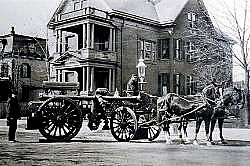For the past five years, students in the Four Corners course at Common Ground Charter High School have been mapping the histories of neighborhoods throughout New Haven. Now, they are publishing their findings on a new website.
History teacher Joel Tolman and his students describe their project to WKCD:
 Tolman: The Four Corners course is team-taught by a history and an English teacher. My co-teacher, Monique Frasier, grew up in New Haven; I was a complete newcomer to the city when I started teaching this class five years ago. We start the class with a big project where students create museum exhibits on New Haven neighborhoods for an elementary school in our neighborhood. During the second half of the class, we shift from a focus on the history of the whole city to the stories of particular neighborhoods. The whole class is 13 weeks long.
Tolman: The Four Corners course is team-taught by a history and an English teacher. My co-teacher, Monique Frasier, grew up in New Haven; I was a complete newcomer to the city when I started teaching this class five years ago. We start the class with a big project where students create museum exhibits on New Haven neighborhoods for an elementary school in our neighborhood. During the second half of the class, we shift from a focus on the history of the whole city to the stories of particular neighborhoods. The whole class is 13 weeks long.
 We set the kids up in neighborhood teams that they pick, so they get to choose a neighborhood that they’re interested in learning more about. Then, it’s their job to collect the stories. In the past, we’ve created walking tours and developed descriptions and histories of several different neighborhoods. This year, we’ll really focus in on specific stories for the “Essay” section of the website.
We set the kids up in neighborhood teams that they pick, so they get to choose a neighborhood that they’re interested in learning more about. Then, it’s their job to collect the stories. In the past, we’ve created walking tours and developed descriptions and histories of several different neighborhoods. This year, we’ll really focus in on specific stories for the “Essay” section of the website.
Common Ground is grades 9-12, and there are roughly 150 students in the whole school. School-wide, we have an environmental focus. A lot of our courses, like this one, take the local environment and the local community as their organizing focus. There are courses on environmental justice and one on power, which is a  team-taught science and politics class focusing on energy issues. The school has a farm on school grounds and it’s on the grounds of a state park. About ninety percent of the students are New Haven city kids, and 10 percent come in from the suburbs. Sixty five percent are African American, about 25 percent are Hispanic, and more than three quarters qualify for free lunch. While they start all over the place, academically speaking, ninety percent of our students get into college.
team-taught science and politics class focusing on energy issues. The school has a farm on school grounds and it’s on the grounds of a state park. About ninety percent of the students are New Haven city kids, and 10 percent come in from the suburbs. Sixty five percent are African American, about 25 percent are Hispanic, and more than three quarters qualify for free lunch. While they start all over the place, academically speaking, ninety percent of our students get into college.
Our class has the full range of ninth to twelfth graders. That’s tough sometimes, but it’s also really good, because if we have ninth graders that are ready to jump into a class that provides higher challenge, they can take this class. The class this year has 27 students.
One of our main desires, especially with the website, is to create a public audience for our students, so that they are experts in their neighborhoods. They know these places as well as anybody. They are well positioned to tell these stories, do the historical research, and do the writing. They are writing for an audience that matters to them. This project allows them to take what they are experts in and link that to the content that we want to teach them anyway, which is U.S. history and English writing skills. But now they are writing for a purpose.
are writing for a purpose.
What’s new and exciting is that we’ve been talking with our local historical society and with another high school in town that independently came up with a similar idea. We’re now working to engage students at possibly a few other schools in developing content for the site.
Eleventh grader David Spears, 16:
We’re actually researching a neighborhood in New Haven. I’m in charge of the Newhallville area, which is where I live. I’m writing about something called “redlining,” where a bank looks at the community that you live in and they look at the number of minority people in it and they declare it red or yellow, with red being the worst. If you live in a red area, a minority area, it was hard to get the bank to give you money to live there. Ninety-eight percent of the people in my area are minorities.
I never knew redlining existed. It relates to the segregation of neighborhoods that naturally exists.
I think this class is pretty great. Being a resident of New Haven, not too many people actually know about it. It’s given me the opportunity to delve into my city. Although I might not like certain parts of my city, I actually know about it now.
Eleventh grader Latelia Bunch, 17:
In the beginning of the class, I knew nothing about New Haven, because I’m from West Haven. The process has definitely changed the way I think about New Haven. Right now, I’m doing a project on the Boys and Girls Club that is in the Hill neighborhood. I set up an interview so I can go there and write an essay on it.
I think it’s a really great project. I knew nothing about the city, and now I can actually tell people about it. It’s helped me to understand New Haven. At other schools I went to, we never focused on a neighborhood. In this class, first you focus on the whole community, then you focus on sections of New Haven. It’s a good experience.
Eleventh grader Ashly Santana, 17:
In the beginning of the course, me and a group of other students were making a project for children at Katherine Brennan School. We were doing a project about food, from 1600 to the present day. It’s a really interactive, huge book. It’s like three feet by two feet. It was basically explaining each year to the children with a little bit of background info about what happened that year. We had coloring books. We also put together a little interactive thing where they would make ice cream for themselves while learning about how ice cream was made. We came up with the idea. At first we were just going to hand them out little packets of information, but we thought that was boring.
Common Ground teaches you things that you will actually need in the future. They teach you life skills. I absolutely love it, I wouldn’t want to be anywhere else.
Now, we’re doing a project on agencies in New Haven that help out. My essay is based on the Community Action Agency. I have an interview coming up pretty soon to talk and take a tour and get some information and history on them. They are a really big agency that helps minorities and anyone else who needs the help
I’ve lived in New Haven for most of my life, and some of the things we learned in class I knew nothing about. What you didn’t know, you’re going to know now!
Click here to see students’ website.
Bookmark with: ![]() Digg
Digg
![]() StumbleUpon
StumbleUpon
![]() Delicious
Delicious
![]() Reddit What are these?
Reddit What are these?


